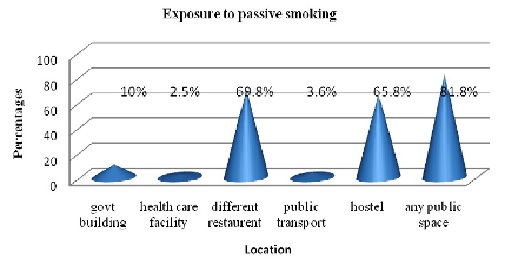Prevalence of exposure to passive smoking and awareness about its ill effects among medical college undergraduate students in Mangalore
Abstract
Introduction: Passive smoking, it is the combination of side stream smoke given off by a burning tobacco product and mainstream smoke exhaled by a smoker. Exposure to passive smoking can take place in the home, the workplace or other environment that are accessible to the public places.
Aim: To estimate the prevalence of exposure to passive smoking and awareness about its ill effects among Medical colliege undergraduate students in Mangalore.
Materials and Method : This was a cross sectional study was conducted among 400 randomly selected undergraduate students in one of the medical college in Mangalore. Data was obtained by using a pre tested, structured questionnaire.
Results: Among the total 400 students, 216 were males and 184 were females. Of the 400 students 10.25% were smokers ( 18.9% males, 0% females) 12.75% past smookers (20.3% males, 3.8% females) , 77.0% were non smokers. Awareness of passive smoking among all participants was 86.5% . Most of the people were exposed to passive smoking (96.25%) in public places in last thirty days. 61.5% students were exposed to passive smoking in their hostel daily (males=88.8%, females= 29.3%) . 42.3% replied passive smoking causes serious health hazard, 2.8% told that it is not at all a health hazard.
Conclusion: Self-reported tobacco use status, parents tobacco use, close friends smoking, and participants residence were the signaficant determinants of exposure to pasive smoking at home and outside the home. Knowledge regarding ill effects of passive smoking varied among students.
Downloads
References
2. National Toxicology Program. Report on Carcinogens. 11th ed. U.S.Department of Health and Human Services, Public Health Service,National Toxicology Program, 2005.
3. U.S. Department of Health and Human Services. The health consequences of involuntary exposure to tobacco smoke. A Report of the Surgeon General. Rockville, MD: U.S. Department of Health and Human Services, Centers for Disease Control and Prevention, Coordinating Center for Health Promotion, National Center for Chronic Disease Prevention and Health Promotion, Office on Smoking and Health, 2006.
4. Baker R R, Proctor CF. The origins and properties of environmental tobacco smoke. Environment International, 16:231–245. (1990)
5. Jenkins R A, Guerin MR, Tomkins BA: Properties and measures of environmental tobacco smoke. In The chemistry of environmental tobacco smoke: composition and measurement.2000. Lewis Publisher, p. 77–106.
6 Öberg M, Jaakkola MS, Woodward A, Peruga A, Pruss-Ustun A . Worldwide burden of disease from exposure to second-hand smoke: a retrospective analysis of data from 192 countries. Lancet 2011 Jan ; 377: 139-146. http://dx.doi.org/10.1016/S0140-6736(10)61388-8
7.Schwartz R, Wipfli H, Samet J. World No Tobacco Day 2011: India’s progress in implementing the framework convention on tobacco control. Indian J Med Res 2011;133:455–7
8. The Global Youth Tobacco Survey Collaborative Group. Tobacco use among youth: a cross country comparison. Tob Control. 2002;11: 252–270.
9. Centers for Disease Control and Prevention. National Healthy Interview Survey questionnaires, flashcards, field representative manual, survey flowchart. Available at: ftp://ftp.cdc.gov/pub/Health_Statistics/ NCHS/Survey_Questionnaires/NHIS/2000/ Accessed june, 2014.
10. The National Partnership to Help Pregnant Smokers Quit. Smoke free Families Core Baseline Assessment Form. Available at: http://www.helppregnantsmokersquit. org/resources/all.aspx. Accessed on august, 2014.
11.Brian A King: A cross-country comparison of secondhand smoke exposure among adults: findings from the Global Adult Tobacco Survey (GATS): Tob Control. 2013 July ; 22(4); Tob Control. Author manuscript; available in PMC 2015 October 13
12. World Health Organization. MPOWER: a policy package to reverse the tobacco epidemic. Geneva: World Health Organization, 2008
13. The GTSS Collaborative Group. A cross country comparison of exposure to second hand smoke among youth. Tob Control 2006;15:ii 4‑19.
14. Raute, et al.: Determinants of exposure to SHS among students in Mumbai: Indian Journal of Cancer | October-December 2012 | Volume 49 | Issue 4
15. J T Lee ,et al: Association between smoke-free workplace and second-hand smoke exposure at home in India: Lee JT, Tob Control 2013;0:1–5

Copyright (c) 2016 Author (s). Published by Siddharth Health Research and Social Welfare Society

This work is licensed under a Creative Commons Attribution 4.0 International License.


 OAI - Open Archives Initiative
OAI - Open Archives Initiative


